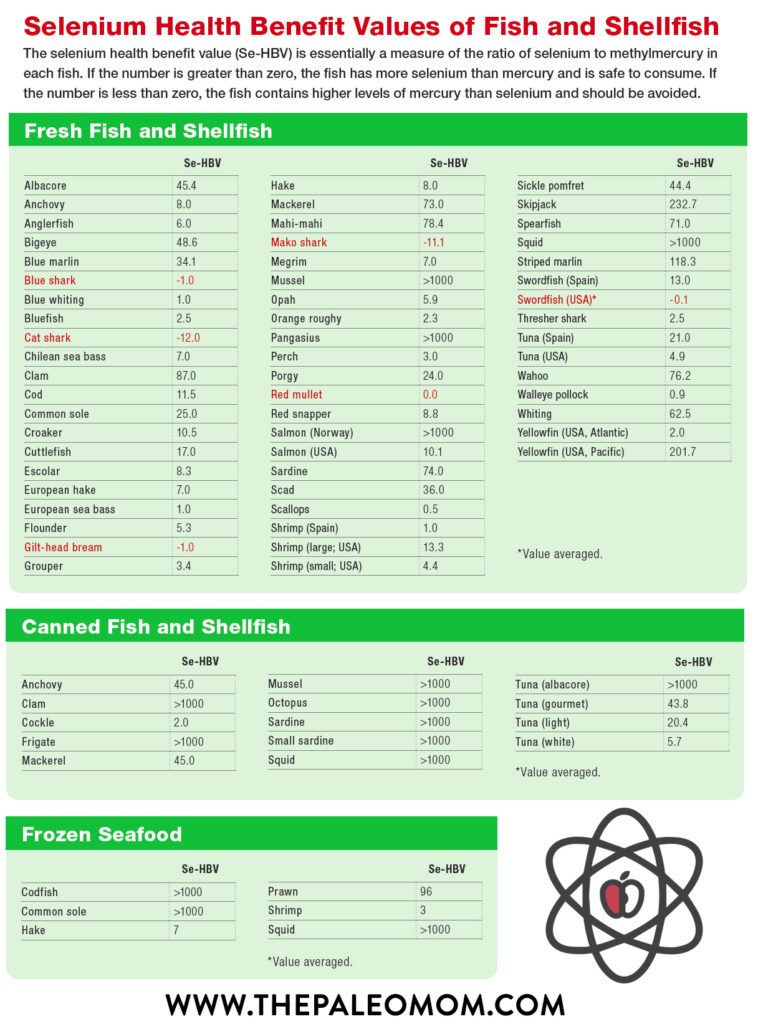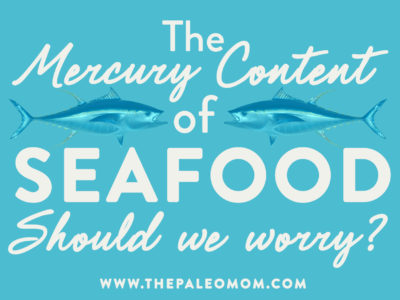We are often warned not to consume too much seafood over fears of the mercury contamination in these foods building up in our systems and leading to mercury poisoning. Pregnant women are advised to limit seafood consumption to just two 6oz-servings per week over fears that mercury will cause brain damage to the developing fetus. It certainly sounds scary, but is this concern well founded?
Table of Contents[Hide][Show]
Mercury in Foods
Mercury is present in all foods. Concentrations are quite low in fruits and vegetables because mercury uptake by plants from soil is low. In contrast, mercury levels can be quite high in certain types of fish because fish absorb mercury from the water and from the organisms that they consume. Methylmercury, an organic form of mercury, is the predominant form of mercury in fish. It is concentrated in the muscle of the fish (not in the fat, which is why paying for low-mercury fish oil is quite pointless) and, because it binds so tightly to certain proteins in fish, it accumulates over time. Fish at the lower end of the food chain tend to contain very low levels of methylmercury; but fish that eat other fish tend to have a higher concentration of methylmercury (this process is called biomagnification).
The concern over consumption of methylmercury is that, when ingested, it is almost completely absorbed from the gastrointestinal tract and distributed to all tissues (elemental or inorganic forms of mercury are not easily absorbed and some methylmercury is converted into elemental forms by your gut microflora). Methylmercury also readily crosses both the blood-brain barrier and the placenta. High levels of methylmercury are known to cause damage to the central and peripheral nervous system (the term “mad as a hatter” comes from felt makers in the 18th and 19thcenturies eventually going crazy due to chronic mercury exposure; mercury was used in felt production which was a common material in hats). Yep, this definitely all sounds scary.
However, studies evaluating the effects of seafood consumption on the developing fetus have varied tremendously in their results. On one end of the spectrum is brain damage (albeit subtle) from methylmercury exposure and on the other end of the spectrum is enhanced cognitive ability attributed to a maternal diet rich in omega-3 fatty acids (DHA, in particular). So, should we eat more seafood or less? The answer lies is in the selenium content of the seafood being eaten.
Selenium vs. Mercury
Selenium is a mineral that is required for activity of 25–30 different enzymes (selenoenzymes), whose job it is to protect the brain from oxidative damage. Methylmercury irreversibly binds to selenium. This is bad if you are exposed to methylmercury because it renders selenoenzymes inactive. In fact, this is the mechanism through which methylmercury is believed to damage the brain and nervous system, by inhibiting the ability of selenoenzymes to protect these tissues from oxidants. Very importantly, most typically consumed varieties of ocean fish contain much more selenium than methylmercury. This is good for the fish (they don’t die from mercury exposure), but it is even better for us. Selenium-bound methylmercury is not efficiently absorbed by our bodies. What methylmercury is absorbed is already bound to selenium so it can’t interfere with our selenoenzymes. The only fish that need to be avoided are those which contain more methylmercury than selenium (which is a fairly short list).
Fish that tend to contain very low levels of methylmercury include shellfish (for example oysters, clams, scallops, mussels), salmon, crab, shrimp, trout, herring, haddock, pollock (Boston bluefish), sole, flounder, lobster, Atlantic mackerel and lake whitefish. However, any fish that has a higher selenium content than methylmercury contamination are perfectly safe to consume. This includes the vast majority of ocean fish and approximately 97% of fresh water fish. In fact, the only fish that you need to avoid are: pilot whale, tarpin, swordfish, shark, marlin, king mackerel, and tilefish. These recommendations are based on various small scale studies (see links below). The EPA is currently undergoing a comprehensive survey of fresh and salt water fish and assigning what is called the Selenium-Health Benefit Value (Se-HBV) to each type of fish, which is essentially a ratio of selenium to methylmercury content of each fish.
Increasing your dietary intake of selenium is one way to protect yourself from mercury exposure from food sources or from environmental factors (broken compact fluorescent light bulbs or amalgam fillings). Selenium is found abundantly in seafood, seaweed, mushrooms, onions, Brazil nuts, sunflower seeds, and meat and poultry (especially the liver). The vast majority of the fish that you are likely to find in a store or restaurant are perfectly safe to eat (swordfish being the obvious exception). In fact, the dietary selenium that you will gain from including fish and shellfish in your diet (not to mention all the good DHA and EPA omega-3 fatty acids, iodine and very easily digested protein) will promote better health.
Selenium-Health-Benefit Values
The selenium health benefit value (Se-HBV) is essentially a measure of the ratio of selenium to methylmercury in each fish. If the number is greater than zero, the fish has more selenium than mercury and is safe to consume. If
the number is less than zero, the fish contains higher levels of mercury than selenium and should be avoided.

Scientists are just starting to understand the variability of the selenium health benefit value within a species of fish or shellfish and why some types of fish naturally have higher values than others (variability is due to the type of fish, size/age of the fish, geographic location and migration routes, and exact diet of the fish). Also note that selenium levels have not been measured in several species known to have high mercury, like tilefish and king mackerel. However, the take-home message is that most fish have positive selenium health benefit values, reflecting higher selenium than mercury levels, and are therefore safe to consume.
Nutrivore Weekly Serving Matrix
An easy-to-use and flexible weekly checklist
to help you maximize nutrient-density.
The Weekly Serving Matrix is very helpful! I’ve been eating along these lines but this really helps me know where to focus vs. which foods serve a more secondary role. It’s super helpful and has taken a lot of worry out of my meal planning. Thanks!
Jan
No Limits on Fish Consumption!
No, you don’t need to worry about the mercury content of (most) fish. Actually, I recommend increasing your consumption of fish rather than decreasing, even for pregnant women! Aiming for three 6oz servings of oily cold-water fish per week (on top of other varieties of fish and types of seafood) will provide you with your recommended intake of DHA and EPA. And if you have unresolved inflammation, eating even more fish is a good idea. Also, see Should We Be Worried About Radiation from Fukushima?
More information:
Burger, J. and Gochfeld, M., Selenium and mercury molar ratios in commercial fish from New Jersey and Illinois: variation within species and relevance to risk communication. Food Chem Toxicol. 2013; 57: 235-45
Kaneko, J. J. and Ralston, N. V. Selenium and mercury in pelagic fish in the central north Pacific near Hawaii. Biol Trace Elem Res. 2007; 119(3): 242-54
Olmedo, P., et al., Determination of essential elements (copper, manganese, selenium and zinc) in fish and shellfish samples. Risk and nutritional assessment and mercury-selenium balance. Food Chem Toxicol. 2013; 62C: 299-307Ralston, NVC. “Selenium Health Benefit Values as Seafood Safety Criteria” EcoHealth 5, 442–455, 2008
Ralston, NVC et al. “Dietary and tissue selenium in relation to methylmercury toxicity” Neurotoxicology. 2008 Sep;29(5):802-11.
Western Pacific Regional Fishery Management Council http://wpcouncil.org/
Selenium and Mercury Ratio Graphic URL: http://www.wpcouncil.org/councilmtgs/145th/Selenium_Poster_final.pdf
Energy & Environmental Research Center, University of North Dakota (EERC).” EERC Research Finds Mercury Levels in Freshwater and Ocean Fish Not as Harmful as Previously Thought”. June 22, 2009. Accessed at http://www.undeerc.org/news/newsitem.aspx?id=343
Health Canada,Bureau of Nutritional Sciences, Food Directorate, Health Products and Food Branch “Human Health Risk Assessment of Mercury in Fish and Health Benefits of Fish Consumption.” March 2007. Accessed at http://www.hc-sc.gc.ca/fn-an/pubs/mercur/merc_fish_poisson-eng.php
http://chriskresser.com/is-eating-fish-safe-a-lot-safer-than-not-eating-fish#fn-672-1
http://cfpub.epa.gov/ncer_abstracts/index.cfm/fuseaction/display.highlight/abstract/9503







 Greek-Inspired Slow-Roasted Leg of Lamb
Greek-Inspired Slow-Roasted Leg of Lamb